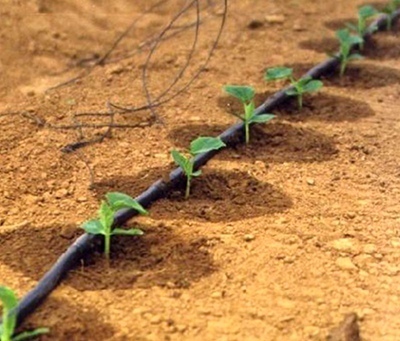Irrigation pipes are one of the impotant parts in drip irrigation system. And The research on the pattern of soil water movement in drip irrigation is the premise of designing and managing drip irrigation system correctly. The characteristics of water diffusion in soil under drip irrigation are explained in detail below.
Water distribution in drip irrigation
The movement of water in soil under drip irrigation is a three-dimensional infiltration problem. The water supplied by the emitter moves through the soil pores, and the water changes are different in horizontal, vertical and other directions. The horizontal water movement force is mainly the matrix potential gradient, while the vertical water movement force has the gravity potential gradient in addition to the matrix potential gradient. Especially when the infiltration duration increases, the gravity potential effect will become more and more obvious.
At the beginning of infiltration, the volume of soil wetting body is very small. And a very high matrix potential gradient is formed at the wetting front. The advancing speed of wetting front is higher. With the continuous infiltration of water, the volume of the wetting body expands, and the matrix potential gradient from the water surface to the edge of the wetting front decreases sharply, which leads to the rapid decrease of the advancing rate of the wetting front with the extension of infiltration time.
After the water supply stopped, the water content in the upper layer decreased gradually, while that in the lower layer increased gradually. With the extension of time, the change rate of water became slower and slower. After water infiltration and redistribution, the shape of soil moist body can be roughly divided into three shapes: semi ellipse, semi circle and parabola.
The shape of soil infiltration at the end of irrigation depends on soil characteristics, emitter discharge, initial soil moisture content, irrigation amount and emitter spacing.
① Soil properties: with the different types of soil (or the increase of soil viscosity), the geometric size of moist body gradually decreases. The wet body of heavy loam is wide and shallow, while that of sandy loam is narrow and deep.
② Emitter flow: the wetting distance in vertical direction decreases with the increase of emitter flow rate, while that in horizontal direction increases.
③ Initial soil moisture content: the greater the initial water content, the slower the soil water movement. In the same infiltration period, the horizontal migration distance of wetting front decreases with the increase of initial soil moisture content, and the vertical migration distance increases with the increase of initial soil moisture content.
④ Distance between emitters: the discharge and spacing of emitters are related to the soil suction between the wet areas of point sources. on sandy soil, the distance between emitters should be smaller or the discharge of emitters should be increased. The distance between emitters in field drip irrigation is generally small, which connects the wetting areas under the emitters and forms a moist zone along the direction of drip irrigation pipes, namely line source drip irrigation.
⑤ Irrigation amount: with the increase of irrigation amount, the horizontal and vertical movement distance of wetting front is increasing.

